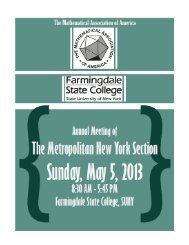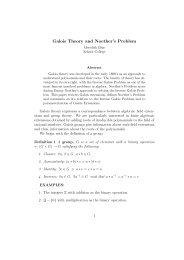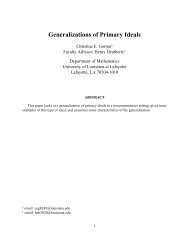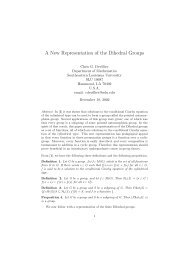The Enjoyment of Elementary Geometry Li Zhou ... - MAA Sections
The Enjoyment of Elementary Geometry Li Zhou ... - MAA Sections
The Enjoyment of Elementary Geometry Li Zhou ... - MAA Sections
You also want an ePaper? Increase the reach of your titles
YUMPU automatically turns print PDFs into web optimized ePapers that Google loves.
<strong>The</strong> <strong>Enjoyment</strong> <strong>of</strong> <strong>Elementary</strong> <strong>Geometry</strong><br />
<strong>Li</strong> <strong>Zhou</strong><br />
Polk Community College<br />
lzhou@polk.edu<br />
February 20 - 21, 2004<br />
A Well-known Exercise<br />
(a) As appeared in a trigonometry textbook (Larson, Hostetler, & Edwards):<br />
A photographer is taking a picture <strong>of</strong> a 4-foot-tall painting hung in an art gallery. <strong>The</strong> camera lens is<br />
1 foot below the lower edge <strong>of</strong> the painting. <strong>The</strong> angle " subtended by the camera lens B feet from<br />
the painting is<br />
%B<br />
B& #<br />
" œ arctan , B !.<br />
Use a graphing utility to graph " as a function <strong>of</strong> B. Move the cursor along the graph to<br />
approximate the distance from the picture when " is maximum.<br />
(b) As appeared in a calculus textbook (Larson, Hostetler, & Edwards):<br />
A photographer is taking a picture <strong>of</strong> a 4-foot painting hung in an art gallery. <strong>The</strong> camera lens is 1<br />
foot below the lower edge <strong>of</strong> the painting. How far should the camera be from the painting to<br />
maximize the angle subtended by the camera lens?<br />
B<br />
Solution. Let " and Bbe as above. <strong>The</strong>n " œ arccot arccot B. So<br />
&<br />
. " #<br />
"Î& " & " %Ð&B Ñ<br />
.B<br />
œ <br />
" "B<br />
œ<br />
#&B<br />
<br />
"B<br />
œ<br />
B #<br />
# # # Ð#&B# ÑÐ"B#<br />
Ñ<br />
#&<br />
.<br />
Setting " œ! and applying the First Derivative Test, you can conclude that Bœ È&<br />
yields a<br />
.B<br />
maximum value <strong>of</strong> ".<br />
.<br />
<strong>The</strong> Origin <strong>of</strong> the Problem<br />
In 1471 Regiomontanus posed the following problem in a letter to Christian Roder, a Pr<strong>of</strong>essor at<br />
Erfurt:
At what point on the ground does a perpendicularly suspended rod appear largest (i.e., subtends<br />
the greatest visual angle)?<br />
Regiomontanus<br />
- Born in Unfinden, near the town <strong>of</strong> Königsberg in Franconia, in 1436. Died in 1476 in Rome.<br />
He was a man known by many names:<br />
Johann Müller<br />
Johannes Germanus (because he was a German)<br />
Johannes Francus (because Franconia was known as Eastern France)<br />
Johann von Kunsperk (after the town <strong>of</strong> Königsberg)<br />
Regio Monte (Latin translation <strong>of</strong> Königsberg, "the royal mountain")<br />
Joannes de Monte Regio<br />
Regiomontanus<br />
He is best remembered for the book: De triangulis omnimodis ( On Triangles <strong>of</strong> Every Kind), written<br />
in 1464, printed in 1533. We quote a wonderful paragraph from the introduction <strong>of</strong> this book:<br />
"You, who wish to study great and wonderous things, who wonder about the movement <strong>of</strong> the<br />
stars, must read these theorem about triangles. ... For no one can bypass the science <strong>of</strong> triangles<br />
and reach a satisfying knowledge <strong>of</strong> the stars. ... A new student should neither be frightened nor<br />
despair. ... And where a theorem may present some problem, he may always look down to the<br />
numerical examples for help."<br />
A Geometric Solution<br />
Suppose that the upper and lower edges Eand F <strong>of</strong> the painting are + and , feet above the<br />
horizontal line 6 at the level <strong>of</strong> the camera lens. Draw the circle through EßF and tangent to 6, then<br />
it is easy to see that " is maximum at the tangency point. By the power <strong>of</strong> a point, this optimal<br />
distance is Bœ È+,<br />
.
VIP Seats in a Multiplex Stadium-seating Movie <strong>The</strong>ater<br />
Once in my class, I phrased the question as finding the best parking spot in a drive-in theater to<br />
maximize the (vertical) viewing angle. It is then only natural to ask:<br />
Where are the best seats in a multiplex stadium-seating theater to maximize the viewing angle <strong>of</strong><br />
your favorite Hollywood stars, car chases, explosions and other special effects?<br />
<strong>The</strong> geometric solution is still valid, with 6 changed to the tilted line joining the audience's eye-<br />
levels.<br />
A Ruler-compass Construction<br />
+, # +, #<br />
Note that +, œ Ð Ñ Ð Ñ . So B œ È<br />
+, +,<br />
+, œ ÉÐ Ñ# Ð Ñ#<br />
, which can be<br />
# # # #<br />
constructed by Pythagorean <strong>The</strong>orem.<br />
Another Ruler-compass Construction from the CRUX<br />
Problem 2822 [2003, 114]. Proposed by Peter Y. Woo, Biola University, CA<br />
Suppose that C is a parallelogram with sides <strong>of</strong> lengths #+ and #, and with acute interior angle !,<br />
and that J and J w are the foci <strong>of</strong> the ellipse A that is tangent to the four sides <strong>of</strong> C at their mid-<br />
points.<br />
(a) Find the major and minor axes <strong>of</strong> A in terms <strong>of</strong> +, , , and !.<br />
(b) Find a straight-edge and compass construction for J and J w .<br />
Solution.<br />
# #<br />
# #<br />
? @<br />
+ Ð, sin! Ñ<br />
(a) Let I be the ellipse œ " and V the rectangle tangent to I at its ?ß@-intercepts.<br />
Under the affine change <strong>of</strong> coordinates<br />
” ? • ” " cot! cos) •” sin)<br />
œ<br />
•” B<br />
@ ! " sin) cos)<br />
C<br />
•<br />
#<br />
# # #<br />
# #<br />
+, cos# !<br />
#<br />
B C<br />
, sin# !<br />
E F<br />
with cot #) œ , V is transformed to C and I to A with equation œ ", where<br />
Eσ+ # , # G #<br />
Fσ+ # , # G #<br />
Gœ È%<br />
, , and +<br />
%<br />
#+,<br />
# #<br />
cos #!<br />
,<br />
%.<br />
# #
È # #<br />
1<br />
#<br />
!<br />
(b) By the law <strong>of</strong> cosines, :œ + , #+, cos Ð Ñ and ;œ<br />
È+ #<br />
,#<br />
1<br />
#+, cos Ð ! Ñ can be constructed. Now, we notice that G œ È:; œ<br />
#<br />
:; :;<br />
# # # #<br />
ÉÐ Ñ# Ð Ñ# G E œ É+ #<br />
,<br />
#<br />
G<br />
#<br />
F œ É+ #<br />
,<br />
#<br />
G<br />
#<br />
. So we can construct , thus and as<br />
well.<br />
w<br />
Finally, let # , in order to satisfy nTHE œ nTFG œ %& °. <strong>The</strong>refore, JM Ÿ JEand<br />
LN Ÿ LG, where M and N are the feet <strong>of</strong> the perpendiculars from J and L to GK and EI<br />
respectively. If GK²IE, then JMŸJEœLN ŸLG œJM, which forces all the<br />
equalities to hold. Thus MœHand NœF, and EFGHis a square. Otherwise, without loss <strong>of</strong><br />
generality, we may extend IE beyond E to intersect GK beyond K at O. <strong>The</strong>n JE LN Ÿ<br />
LG, and therefore JM LN œ LG JE ÐLG JEÑsin nGOI LG JE. This<br />
contradiction completes the pro<strong>of</strong>.
Erdös-Mordell-Barrow Inequality<br />
<strong>The</strong> case <strong>of</strong> 8œ$ <strong>of</strong> the above MONTHLY problem is also true. In fact, it is an immediate<br />
consequence <strong>of</strong> the famous Erdös-Mordell-Barrow Inequality:<br />
Let T be a point in the interior <strong>of</strong> a triangle EFG . Let < , = , and > be the distances from T to the<br />
vertices, and let BC , , and D be the distances from T to the sides. <strong>The</strong>n<br />
<br />
#ÐBCDÑ,<br />
with equality if and only if EFG is equilateral.<br />
Pro<strong>of</strong>. Let I and J be the feet <strong>of</strong> the perpendiculars from T to GE and EF. By the law <strong>of</strong><br />
# # # # # # #<br />
cosines, IJ œC D #CDcosnITJ œ C D #CDcosEœC D <br />
# # #<br />
#CDcosÐFGÑœÐCsinGDsinFÑ ÐCcosGDcosFÑ ÐCsinGDsin FÑ . Hence<br />
EI EI IJ sinG sinF sinE sinG<br />
sinnET I sinnEJ I sinE sinE sinE sinF sinF<br />
B C . By the AM-GM inequality #, etc., completing the pro<strong>of</strong>.<br />
Brocard Points<br />
This special case <strong>of</strong> 8œ$ leads us further to the Brocard points. <strong>The</strong>y are named after Henri<br />
Brocard, a French army <strong>of</strong>ficer, who described them in 1875. However, they had been studied<br />
earlier by Jacobi, and also by Crelle, in 1816. Crelle was led to exclaim:<br />
"It is indeed wonderful that so simple a figure as the triangle is so inexhaustible in properties. How<br />
many as yet unknown properties <strong>of</strong> other figures may there not be?"<br />
For any triangle there is a unique angle = , the Brocard angle, and points H and H', the<br />
w w w<br />
Brocard<br />
points, such that = œnHEFœnHFGœnHGEœnHEGœnHFEœnHGF.<br />
A Dog Chase in a Triangle<br />
To find the Brocard points, put three dogs at the vertices <strong>of</strong> the triangle and let them chase one<br />
after the other at the same speed. Depending on the directions <strong>of</strong> chasing, clockwise or counterclockwise,<br />
they will end up at the corresponding Brocard points.
<strong>The</strong> Most Important Fact about the Brocard Angle =<br />
cot= œ cotE cotF cotG<br />
An Angle <strong>of</strong> Many Inequalities<br />
For example,<br />
(a) = Ÿ$! ° (equality iff EFGis equilateral);<br />
(b) = $ Ÿ ÐE = ÑÐF = ÑÐG = Ñ;<br />
(c)<br />
# = Ÿ È $<br />
EFG<br />
(d) # Ÿ .<br />
$<br />
=<br />
<br />
" " "<br />
E F G<br />
(the Yff inequality);<br />
An IMO Problem<br />
IMO Problem 1991/5. Let EFG be a triangle and T an interior point in EFG . Show that at least<br />
one angles nT EF, nT FGß nT GE is less than or equal to $! °.<br />
Solution. T must be in one <strong>of</strong> the three smaller triangles HEF, HFG, or H GE. Since = Ÿ $! °,<br />
the pro<strong>of</strong> is complete.<br />
A Recent MONTHLY Problem<br />
A recent MONTHLY problem <strong>of</strong>fers a new inequality <strong>of</strong> the Brocard angle.<br />
Problem 11017 [2003, 439]. Proposed by C. R. Pranesachar, Indian Institute <strong>of</strong> Science, India.<br />
Let T and Ube the Brocard points <strong>of</strong> a non-equilateral triangle X , and let = be the Brocard angle<br />
<strong>of</strong> X .<br />
(a) Prove that the line through T and U passes through a vertex <strong>of</strong> X if and only if the sides <strong>of</strong> the<br />
triangle are in geometric progression.<br />
1 FG<br />
' $<br />
(b) Prove that = min Ò ß Ó, where F and G are the smallest angles <strong>of</strong> X.
FG<br />
1<br />
$ #<br />
Solution to (b). It suffices to show that = if F G . Since cot=<br />
œ cotE cotF <br />
cot G and cot B is a decreasing function <strong>of</strong> B − Ð!ß Ñ, we only need to show that cot <br />
FG<br />
1<br />
$<br />
FG<br />
1<br />
$<br />
_<br />
Using the Euler product sin # B #<br />
. "<br />
81<br />
, we obtain cot<br />
.B<br />
lnsin<br />
B<br />
8œ"<br />
_ _ _ _<br />
! " " " " ! ! " B 5 B 5 " ! #5"<br />
81Ð B<br />
"<br />
B<br />
"<br />
Ñ œ<br />
B<br />
<br />
81ÒÐ 81Ñ Ð81Ñ Ó œ<br />
B<br />
= 5B<br />
81 81<br />
8œ" 8œ" 5œ! 5œ!<br />
_<br />
# FG " " %<br />
5 Ð8 Ñ $ F G FG<br />
8œ"<br />
_<br />
where H œ !<br />
"<br />
#5" #5" #5"<br />
= 5ÒÐ" <br />
$ #5" ÑÐF GÑ F G Ó !<br />
5œ!<br />
cotÐ F GÑ cotF cot G, or equivalently, cot cotF cotG cot ÐF GÑ.<br />
BœB Ò"Ð ÑÓ Bœ Ð BÑœ <br />
, where<br />
= œ ! 1<br />
#5# . Hence, cotF cotG cotÐF GÑ cot œ H,<br />
FG # " " %<br />
#<br />
" "<br />
F G FG<br />
inequality, , thus <br />
, completing the pro<strong>of</strong>.<br />
F<br />
G<br />
. Finally, by the AM-HM<br />
Of course,<br />
" " %<br />
F<br />
<br />
G FG<br />
Back to the Trigonometric Exercise<br />
is merely another expression <strong>of</strong><br />
# #<br />
ÐF GÑ %FG œ ÐF GÑ !, with equality iff F œ G .<br />
%B %B<br />
B& # B& #<br />
Recall that " œ arctan . It suffices to maximize .<br />
%B % " B " B<br />
Note that œ Ÿ , with equality iff œ , i.e. B œ È&<br />
.<br />
B& # &<br />
B B & B &<br />
B<br />
This kind <strong>of</strong> non-calculus ideas seemed to be what Regiomontanus used to solved his problem. It<br />
is not clear whether he actually provided a solution.

















